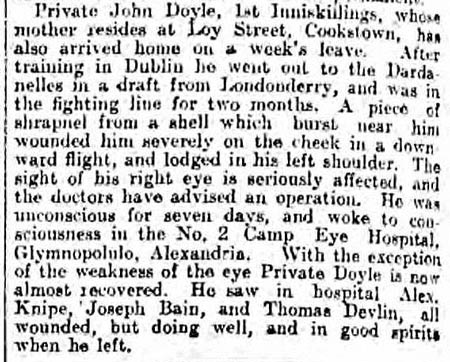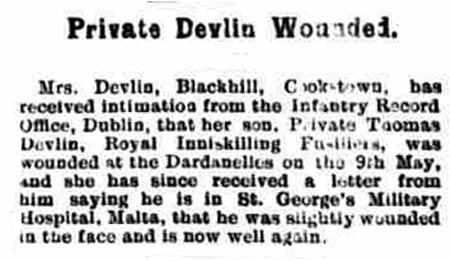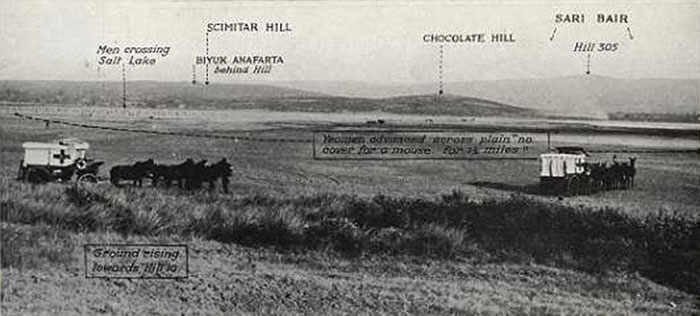| Date |
Information |
|
| 01/05/2020 |
02088 |
| 05/12/2018 |
Private John Doyle, 1st Inniskillings, whose mother resides at Loy Street, Cookstown, has also arrived home on a week’s leave. After training in Dublin he went out to the Dardanelles in a draft from Londonderry, and was in the fighting line for two months. A piece of shrapnel from a shell which burst near him wounded him severely on the cheek in a downward flight, and lodged in his left shoulder. The sight of his right eye is seriously affected and the doctors have advised an operation. He was unconscious for seven days, and woke to consciousness in the No 2 Camp Eye Hospital, Glymnopolulo, Alexandria. With the exception of the weakness of the eye, Private Doyle is now almost recovered. He saw in hospital Alex. Knipe, Joseph Bain and Thomas Devlin, all wounded, but doing well, and in good spirits when he left. |
| 05/12/2018 |
 |
| 05/12/2018 |
From the Belfast Newsletter dated 21st August 1915: |
| 12/10/2018 |
Mrs Devlin, Blackhill, Cookstown, has received information from the Infantry Record Office, Dublin that her son, Private Thomas Devlin, Royal Inniskilling Fusiliers, was wounded at the Dardanelles on 9th May, and she has since received a letter from him saying he is St George’s Military Hospital, Malta, that he was slightly wounded in the face and is now well again. |
| 12/10/2018 |
 |
| 12/10/2018 |
From the Mid Ulster Mail dated 12th June 1915: Private Devlin Wounded |
| 31/05/2017 |
Private Thomas Devlin has no known grave and is commemorated on the Helles Memorial in Turkey. |
| 31/05/2017 |
Thomas and his twin brother Joseph were born on 22nd October 1897 near the village of Coagh. Thomas was one of eight children. |
| 31/05/2017 |
The 1901 census lists Thomas as 4 years old, living with the family at house 7 in Urbal, Coagh. His father was a carter. |
| 31/05/2017 |
Family: Joseph Devlin, Catherine Devlin, Susan Devlin (born about 1892), Sarah Jane Devlin 15 (born about 1896), Thomas James Devlin 13 (born 22nd October 1897), Joseph Devlin 13 (born 22nd October 1897), Patrick Devlin 11 (born 15th March 1900), Agnes Devlin 9 (born 11th November 1902), George Devlin (born 26th February 1905), John Devlin (born 2nd December 1907). |
| 31/05/2017 |
The family moved to Cookstown after 1907 as all the children were born in Coagh. |
| 31/05/2017 |
The 1911 census lists Thomas and Joseph as 13 years old, living with the family at house 3 in Chapelhill Town, Cookstown. Thomas and Joseph had left school and were employed as mill workers. Because of its proximity, it is almost certain to be the Greenvale Mill. |
| 31/05/2017 |
At the outbreak of the First World War Thomas enlisted in the army at Omagh and was posted to the 1st Battalion of the Royal Inniskilling Fusiliers. |
| 31/05/2017 |
Private Thomas Devlin was serving with the 1st Battalion of the Royal Inniskilling Fusiliers in Gallipoli when he was killed in action on Saturday 21st August 1915. |
| 31/05/2017 |
The 21st August 1915 was a day in hell for the 1st Battalion Inniskillings. The objective that day was regarded by Sir Frank Fox (The Royal Inniskillings in the Great War) as ‘The final effort at Suvla Bay.’ |
| 31/05/2017 |
Thomas James Devlin was the son of Joseph and Catherine Devlin. Joseph Devlin married Catherine Rea on 11th May 1896 in the district of Cookstown. |
| 31/05/2017 |
Private Devlin was just17 years old when he was killed in the assault at Scimitar Hill. |
| 31/05/2017 |
The CWGC record Private Thomas Devlin as the son of Joseph and Catherine Devlin, who were by then living at 40 Mill Street, Whiteabbey, Belfast |
| 31/05/2017 |
 |
| 31/05/2017 |
The 1st Battalion had to cross 400 yards of ground. Their objective was Scimitar Hill. The initial attack was left until mid-afternoon as it was thought that the declining sun in the sky would obscure the enemy’s vision, but the weather turned dull and misty, coupled with the dense smoke of burning scrub. It didn’t deter the enemy though as they had trained their sights on the Inniskilling positions. At 15.00 hours the allied artillery bombardment began. The enemy responded at once but caused little damage. At 15.30 hours the Inniskillings advanced and by that time the dry scrub and foliage on the ground had begun to burn as a result of the shellfire. The advance continued up the hill to the first line enemy position but was beaten back by constant shell and machine gun fire, Officers and men were cut down. Every effort to move forward to the second line trench was beaten back and the order was given to fall back 400 yards or so to a small gulley to regroup for another attack. Captain Pike, commanding the battalion in reserve, couldn’t endure the agony of remaining behind in support so he moved to the front and called for a charge, and every man who could follow him, charged over the crest of the hill. No man returned. Then Captain O’Sullivan V.C., an Officer who had proven his mettle many times at Gallipoli, appealed to the few men who left. “One more charge for the honour of the Old Regiment”, he was heard to call out. Any man that could move responded. A small band of about fifty men rushed forward to the crest of the hill. Only one man, a wounded Sergeant returned. 126 men of the 1st Battalion Inniskillings were killed in action and six others died of their wounds the following day. |